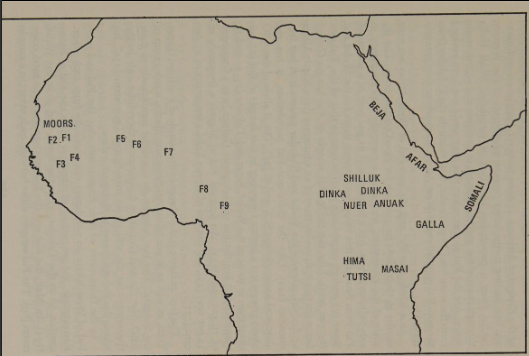Why do the Somali have such thin bodies and large foreheads? This physical type is often explained as an adaptation to desert heat, but occurs in no other desert population outside Africa. The real culprit is milk anemia, a disease common in pastoralists and, once, in Europeans.
There are other African peoples, all pastoralists, that share many aspects of the Somali “look”. The type goes by many names: Hamitic, Cushitic, Ethiopid. Because they are often tall, the Belgian anthropologist Jean Hiernaux categorized them as “Elongated African".
The “F”s on Hiernaux’s map stand for Fulani, another pastoralist people. The Fulani have a striking physical resemblance to East African herders; many I think, could pass as Somali. There is though no close genetic link between them, something Hiernaux guessed 60 years ago.
Early European explorers were so impressed with the Fulani (and charmed by the good looks of their women) that they assumed they were either mostly Caucasian or related to East Africans. Neither is true: Fulani are 3/4th West African. The "Somali" type has evolved more than once.
Maybe more than twice. In the hottest Saharan depths live the Tuareg, another pastoralist people. They are mostly North African by descent, but all the same Carleton Coon thought the closest physical comparison to be found was with the Somali. This keeps happening: Somalification
Some old anthropologists classified the Fulani and Somali as part of the same race, called “Ethiopoid”, as here on the great Human Phenotypes site. What made this mistake understandable was that the Fulani and Somali share not only a build but a coloring: a kind of chocolate red.
When the Turkana first encountered the Maasai, Rendille, and Borana they called them "red people". JR Wilson-Haffenden's book on the Fulani is subtitled "Red Men of Nigeria". The skin color of the Somali has been called bronze, copper, caramel.
The few anthropologists who have studied the issue have all come to the same conclusion: the lean physical type of the “Red Africans” is an adaptation to desert heat. Jean Hiernaux theorized that there are two types of Black African: those adapted to wet and dry environments.
The biophysicist Paul Baker theorized that desert heat imposes a higher degree of stress on the body that typical African wet heat does. World War II-era studies of heat stroke deaths seem to show that lean men are less likely to perish in these environments.
The difficulty with this explanation is that there are other desert peoples outside Africa and none look Somali. The Sonoran Desert is 15+ degrees warmer than Mogadishu in the summer and yet its indigenous peoples, like the Cochimi, do not have bulging foreheads or petite bodies.
What really separates our Red Africans from other desert peoples is their dependance on domestic animals. African pastoralists subsist on a diet very rich in milk, so much so that the Tuareg, Fulani, Tutsi, and Beja have rates of lactose tolerance only exceeded by west Europeans.
In their writings on “Elongated Africans" Hiernaux and Baker didn’t even attempt to explain why desert environments would produce large foreheads in, say, Somalis. But I know of a condition induced by milk consumption which can swell the size of the forehead: the Bahima disease.
In 1962 British doctors in Uganda made note of a number of young patients who had arrived in recent months with swollen foreheads and iron deficiency. The children were all part of the same minority group: the Bahima, close relatives of the Tutsi.
The large foreheads were produced through overproduction of red blood cells in the marrow of the skull. Ruling out malaria or sickle cell disease, the researchers concluded that this iron deficiency came about through excessive drinking of cow’s milk early in life.
Cow's milk can produce anemia not only because it is low in iron, but because its calcium actively interferes with iron metabolism. The addition of milk or cheese to common meals is enough to reduce iron absorption by 50-60%.
Milk anemia was so common among the Bahima that their healers had a standard practice to treat it: they branded circular scars on the head. It may have been common elsewhere: I have seen images of Fulani and Rendille that have the same tower shaped skulls described in the paper.
The authors of the Bahima paper speculated that perhaps this early anemia is related to the ethnic qualities of Tutsi skulls, as though they all suffer from a mild form of the disease. I think though that, being common, natural selection has come to expect it, to fix it in place.
Moreover, the persistence of anemia throughout the lifespan would help to explain the gaunt, “Somali” physique as a body type designed, not to survive desert heat, but to function on a bare minimum of iron.
Some researchers write about milk anemia as though it were a disease only suffered by children, because they reason that only at a young age can cow’s milk be so important in the diet. But among the Tutsi milk could represent >50% of dietary calories even in adulthood.
But even that is not much compared to what you see in Somalia. There were once nomads in that country who would subsist_entirely_ upon camel’s milk, 5 liters worth a day, something I didn’t think was possible.
There are Somali minorities in Ethiopia and Kenya and in both places they are distinguished by their high anemia rates. The Somali region of Kenya was once unique in that blood disorders like anemia were the leading cause of death
If iron deficiency is such a problem, you might ask why the Somali didn’t just evolve higher iron stores. The issue is that higher iron is closely associated with malaria infections, so much so that some doctors feel that giving iron tablets to the anemic hurts more than it helps
5,000 kms to the west, the milk drinking Fulani show the same distinct mortality pattern as the Somali. Compared to their immediate farmer neighbors like the Dogon they have much higher rates of anemia, but lower susceptibility to malaria.
When heavy milk consumption co-exists with malaria the result of selection is a thin body type. Because iron levels remain low, we could call this “acquiescence”. When the same diet is consumed in non-malarial areas the result is “adaptation”: iron overload, hemochromatosis.
Hemochromatosis is recessive: you need two copies of a mutation (C282Y) to develop symptoms. This mutation reaches its peak in Ireland, with other high concentrations in Brittany, Britain, and Scandinavia. Carrying one copy must be advantageous for it to be so common: but how?
A 2016 paper claims the gene spread as a way of increasing thermoregulation in chilly, damp parts of Europe. There’s a very strong correlation (.782) between a country’s number of rainy days and its modern frequency of C282Y.
But there are other peoples outside of Europe who suffer much more from wet cold than the Irish and yet do not have hemochromatosis. For instance, the muscular, short limbed physique of Polynesian seafarers is produced entirely by this kind of stress.
twitter.com/crimkadid/stat

Uriah@crimkadid
May 25 20
View on Twitter
Ok enough of this: WHY are they cold adapted? In 1976 Ben Finney joined a mixed Polynesian-white crew on a reconstructed outrigger, the Hōkūleʻa, which sailed from Hawaii to Tahiti. It was not a fun trip. Heyerdahl also nearly froze to death more than once while on the Kon-Tiki.
Atlantic rains produce green pastures and green pastures great herds of cattle. The frequency of European lactose tolerance largely parallels the northwestern distribution of C282Y: a majority of both Russians and Italians are intolerant. What, though, is special about Ireland?
Before the introduction of the potato c. 1600, the Irish diet revolved around milk to an extent unique in Europe. “According to various English commentators on the Irish scene, milk constituted virtually the sole food of the ordinary people during the summer season.”
Some of the highest frequencies of C282Y outside of Ireland are found in West Brittany. William of Poitiers, the Conqueror's historian, described the Breton way of life c. 1066: "they live on plentiful milk and very little bread.... crops are almost unknown".
The diet of the Irish and Bretons is reminiscent of that of the Germans as described by Caesar. “They make not much use of corn for food, but chiefly of milk and cattle” is often assumed to be exaggeration but the example of Ireland and Somalia suggest this is indeed possible.
This way of life declined on the Continent much earlier than the Celtic fringe: according to Hamerow, the change began c. 700. It is visible in the abandonment of the Germanic longhouse, where men and cattle once lived under the same roof.
Once I was looking for pictures of the Beja and I ran across this fellow. He was the first impossible person I’ve seen: impossible in that I was certain he was a photoshopped white man. The chin, the forehead, the lack of prognathism…none of it seemed right for someone so black.
With time I saw other impossible people among African pastoralists, like this Borana woman. It’s not enough to say she looks “Caucasian”, she looks European in so many different ways as to defy easy explanation. Even the _smile_ is weirdly similar.
I have come to think that in almost all of the physical qualities that mark apart milk drinking Northwest Europeans from their otherwise close relatives (Russians), there are African parallels. Namely, a red flush in the skin, a bulbous forehead, and a well defined chin.
Imagine this thread in reverse: “why do Northwest Europeans look the way they do?” No one would know what I meant: these people are not conscious they have a look at all. If asked themselves they might say “Uh, white skin?” but that's the interesting thing: they _aren’t_ white.
Russians are white. Ashkenazi Jews are white. Dagestanis are white. The peoples of Atlantic Europe are _red_ . They themselves are amazingly oblivious to this. Just as there are milk drinking, red faced African pastoralists, there are milk drinking, red faced European ones.
This is not, I think, a coincidence. There is one ethnic group in the south of Europe who are universally lactose tolerant: the Basques. The Basques are physically unusual in a number of ways, but most obvious to see is a marked red flush which is out of place so far south.
This is as far as I go. But readers who know more about African history than I do will perhaps be able to go even further. People so often tease the Somali for those big heads and never wonder: is there anything useful inside them? What, exactly? A question for someone else.
Missing some tweets in this thread? Or failed to load images or videos? You can try to .


















































